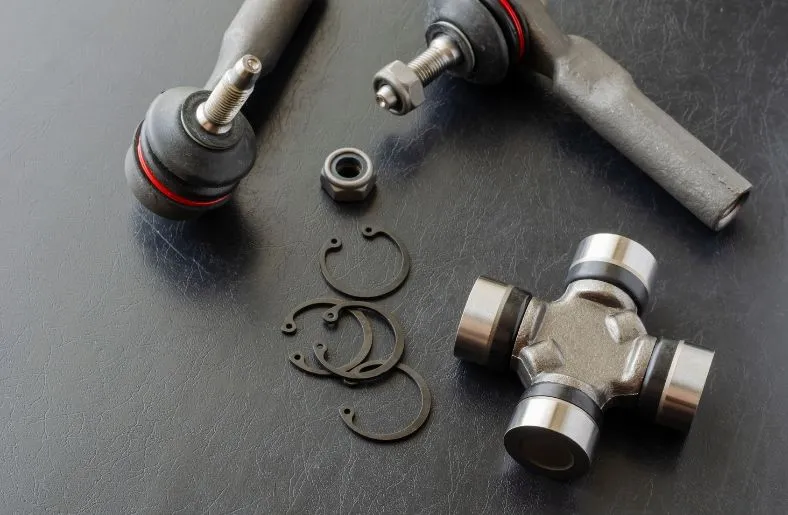Tie rod ends are crucial to your vehicle’s steering system, ensuring precise control and safe handling. Proper maintenance of tie rod ends is essential to keep your vehicle operating smoothly and safely. One key aspect of tie rod end maintenance is greasing, which helps prevent wear and tear but the question arises how often to grease tie rod ends?
In this comprehensive guide, we’ll answer how often to grease tie rod ends. We’ll explore the factors affecting greasing intervals and provide a step-by-step guide to help you effectively maintain your tie rod ends.
Table of Contents
Factors Affecting Greasing Frequency
- Driving Conditions: If you frequently drive in harsh conditions, such as off-road terrain, dusty environments, or areas with extreme temperature fluctuations, you may need to grease tie rod ends more frequently. These conditions can accelerate wear and require more frequent maintenance.
- Mileage: High-mileage vehicles generally require more frequent greasing. As a general guideline, consider greasing tie rod ends every 12,000 to 15,000 miles.
- Vehicle Type: Different vehicles have varying greasing requirements. Heavy-duty trucks and off-road vehicles may need more frequent greasing compared to smaller passenger cars.
- Suspension Modifications: If you’ve made suspension modifications or installed larger tires, your tie rod ends may experience increased stress, necessitating more frequent greasing.
- Grease Quality: The type and quality of grease you use can impact greasing intervals. High-quality, long-lasting grease can extend the time between greasing sessions.
Signs That Your Tie Rod Ends Need Greasing
Regular inspection is crucial to ensure your tie rod ends are adequately greased. Look out for the following signs that may indicate it’s time for maintenance:
- Steering Difficulty: If you notice increased difficulty in turning the steering wheel or if it feels loose, it’s a sign that your tie rod ends may need lubrication.
- Unusual Noises: Squeaking or clunking noises when turning the steering wheel could indicate dry or worn tie rod ends.
- Uneven Tire Wear: Uneven tire wear, such as excessive wear on the inner or outer edges of the tires, can suggest alignment issues caused by poorly lubricated tie rod ends.
How Often to Grease Tie Rod Ends and How to Do It?
Now, let’s explore the process of how often to grease tie rod ends and how to do it to ensure their optimal performance:
- How often to Grease Tie Rod Ends: Tie rod ends should typically be greased as part of routine vehicle maintenance. The frequency can vary depending on driving conditions, but a general guideline is to grease them every 12,000 to 15,000 miles. However, it’s crucial to consult your vehicle’s manual or a qualified mechanic for specific recommendations tailored to your car’s make and model.
- Tools and Materials Needed: Gather the necessary tools and materials before starting. You’ll typically need a grease gun, suitable grease recommended for your vehicle, gloves, and safety glasses.
- Locate the Tie Rod Ends: Jack up your vehicle and secure it on jack stands. Locate the tie rod ends, which are essential components of the steering mechanism connecting the steering rack to the steering knuckle.
- Clean the Grease Fittings: Before greasing, wipe away any dirt or debris from the grease fittings using a clean rag. This ensures a clean connection for the grease gun.
- Attach Grease Gun and Pump Grease: Attach the nozzle of the grease gun to the grease fitting on the tie rod end. Pump the grease gun handle until you feel resistance, indicating that grease is flowing into the joint. Be cautious not to over-grease, as it can lead to excess pressure and potential damage.
- Monitor Grease Flow: While greasing, keep an eye on the joint area to ensure that fresh grease is flowing in. You may see old grease being pushed out, which is normal. Continue pumping until you observe fresh grease emerging from the joint.
- Wipe Excess Grease: Once adequately greased, wipe away any excess grease around the fitting to prevent accumulation of dirt and debris, which could lead to premature wear.
- Repeat for Other Tie Rod Ends: Repeat the greasing process for any other tie rod ends on your vehicle.
- Lower Vehicle and Test: Lower your vehicle from the jack stands and test the steering to ensure smooth operation.
- Document Maintenance: Keep a record of when the tie rod ends were last greased for future reference and to maintain a comprehensive maintenance history for your vehicle.
Always prioritize safety and consult professional guidance or your vehicle’s manual if you’re unsure about any aspect of tie rod end maintenance. Following these steps can help ensure proper lubrication and prolong the lifespan of your tie rod ends, contributing to overall vehicle safety and performance.
Related Guide: How to Grease Tie Rod Ends: A Step-by-Step Guide for Long-lasting Performance (2023-2024)
Conclusion
Properly greasing tie rod ends is essential for maintaining your vehicle’s steering system and ensuring safe and responsive handling. The frequency of how often to grease tie rod ends depends on various factors, including driving conditions, mileage, and vehicle type. Regular inspection and timely greasing can help prolong the life of your tie rod ends and prevent steering-related issues.
By following the steps outlined in this guide and staying attentive to the signs of wear and tear, you can keep your vehicle’s tie rod ends in excellent working condition for miles to come.

